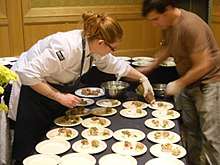Catering
Catering is the business of providing food service at a remote site or a site such as a hotel, hospital, pub, aircraft, cruise ship, park, filming site or studio, entertainment site, or event venue.

History of catering
The earliest account of major services being catered in the United States is a 1778 ball in Philadelphia catered by Caesar Cranshell to celebrate the departure of British General William Howe.[1] Catering business began to form around 1820, centering in Philadelphia.[1][2] Catering became a respectable and profitable business. The early catering industry was disproportionately founded by African-Americans.[1][2][3]
The industry began to professionalize under the reigns of Robert Bogle who is recognized as "the originator of catering."[2] By 1840, the second generation of Philadelphia black caterers formed, who began to combine their catering businesses with restaurants they owned.[2] Common usage of the word "caterer" came about in the 1880s at which point local directories began listing numerous caterers.[1] White businessmen eventually moved into the industry and by the 1930s, the black businesses had virtually disappeared.[1]
In the 1930s, the Soviet Union, creating more simple menus, began developing state public catering establishments as part of its collectivization policies.[4] A rationing system was implemented during World War II, and people became used to public catering. After the Second World War, many businessmen embraced catering as an alternative way of staying in business after the war.[5] By the 1960s, the home-made food was overtaken by eating in public catering establishments.[4]
By the 2000s, personal chef services started gaining popularity, with more women entering the workforce. People between 15 and 24 years of age spent as little as 11–17 minutes daily on food preparation and clean-up activities in 2006-2016, according to figures revealed by the American Time Use Survey conducted by the US Bureau of Labor Statistics.[6]
Mobile catering
A mobile caterer serves food directly from a vehicle, cart or truck which is designed for the purpose. Mobile catering is common at outdoor events such as concerts, workplaces, and downtown business districts.
Seat-back catering
Seat-back catering was a service offered by some charter airlines in the United Kingdom (e.g., Court Line, which introduced the idea in the early 1970s, and Dan-Air[7]) that involved embedding two meals in a single seat-back tray. "One helping was intended for each leg of a charter flight, but Alan Murray, of Viking Aviation, had earlier revealed that 'with the ingenious use of a nail file or coin, one could open the inbound meal and have seconds'. The intention of participating airlines was to "save money, reduce congestion in the cabin and give punters the chance to decide when to eat their meal".[8] By requiring less galley space on board, the planes could offer more passenger seats.[9]
According to TravelUpdate's columnist, "The Flight Detective", "Salads and sandwiches were the usual staples," and "a small pellet of dry ice was put into the compartment for the return meal to try to keep it fresh."[9] However, in addition to the fact that passengers on one leg were able to consume the food intended for other passengers on the following leg, there was a "food hygiene" problem,[8] and the concept was discontinued by 1975.[9]
Shipboard catering
Merchant ships – especially ferries, cruise liners, and large cargo ships – often carry Catering Officers. In fact, the term "catering" was in use in the world of the merchant marine long before it became established as a land-bound business.
Wedding catering
A wedding caterer provides food to the wedding party. The wedding caterer can be hired independently or can be part of a package designed by the venue.

See also
| Look up catering in Wiktionary, the free dictionary. |
- Aircraft ground handling
- Airline meal
- Food trucks
- Gastronorm, a European standard for food container sizes
- Online food ordering
References
- Chastain, Sue (March 5, 1987). "Philadelphia's Historic Feasts How Blacks Carved Out A Niche In Society Through Catering". The Philadelphia Inquirer. Retrieved 1 November 2014.
- Walker, Juliet E. K. (2009). The history of black business in America: capitalism, race, entrepreneurship (2nd ed.). Chapel Hill, N.C.: University of North Carolina Press. pp. 133–134. ISBN 0807832413. Retrieved 1 November 2014.
- Smith, Jessie Carney, ed. (2006). Encyclopedia of African American Business. 1. Greenwood Press. p. 306. ISBN 0313331103.
- Atkins, Peter; Oddy, Derek J.; Amilien, Virginie (2012). The Rise of Obesity in Europe: A Twentieth Century Food History. Ashgate Publishing, Ltd. pp. 35–36. ISBN 1409488330.
- "A Brief History of Catering All Over The World". BLOWOUT PHILIPPINES. 2016-11-26. Retrieved 2016-11-26.
- "Why Millennials Don't Know How to Cook". MarketWatch. Retrieved 29 May 2017.
- "On-Board". Dan Air Remembered. Photo of seat back catering.
- Calder, Simon (May 1, 1999). "Travel" Pioneering Airlines Set Standards that Today's Carriers Could Only Exceed". The Independent. UK.
- The Flight Detective (November 20, 2018). "HAVE YOU HEARD OF THE CONCEPT OF SEAT BACK CATERING ON FLIGHTS?". Travel Update: Boarding Area.
| Wikimedia Commons has media related to Catering. |